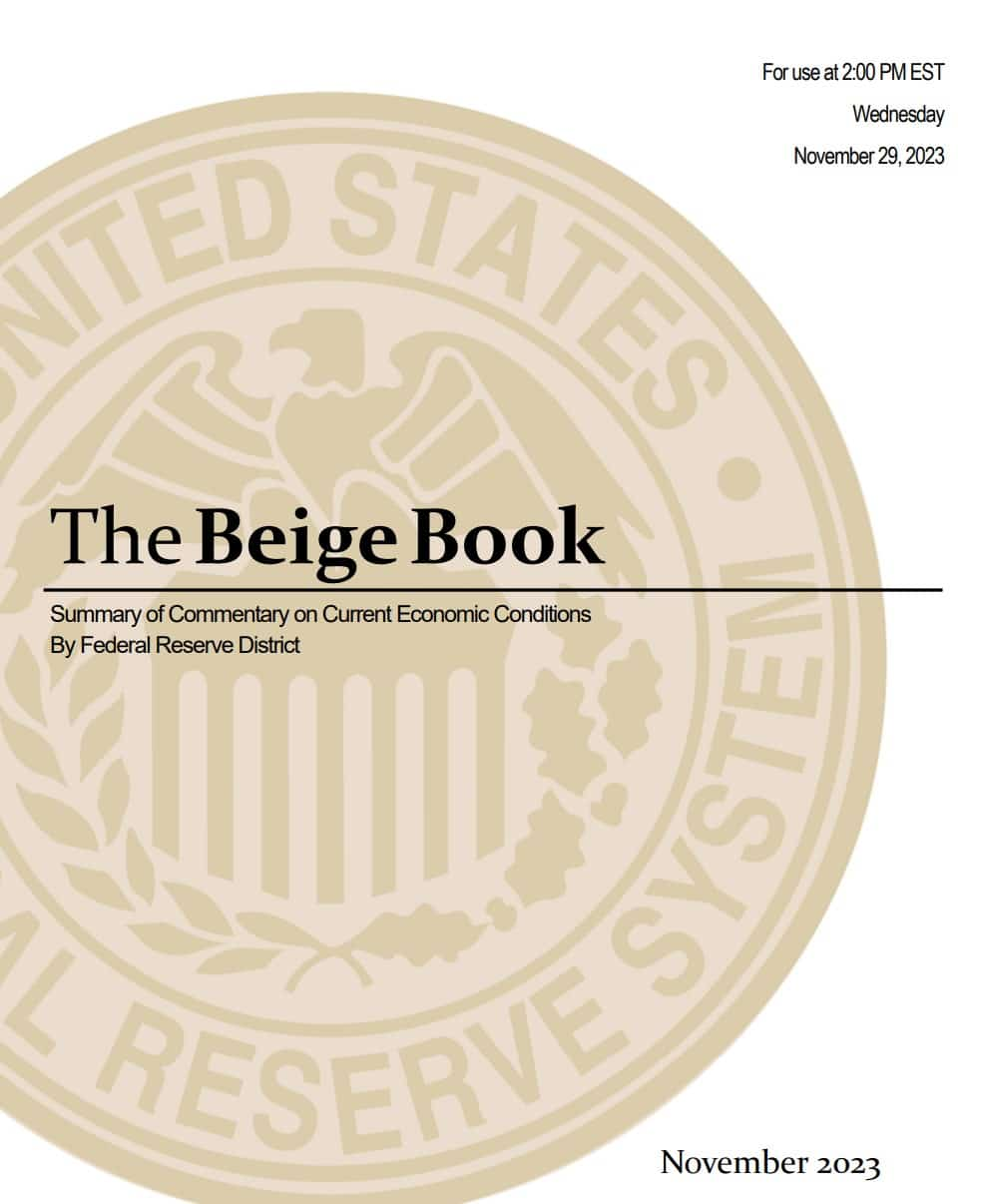Fed Beige Book: "some banks noted a slight uptick in consumer delinquencies." "The economic outlook for the next six to twelve months diminished over the reporting period."


Overall Economic Activity:
On balance, economic activity slowed since the previous report, with four Districts reporting modest growth, two indicating conditions were flat to slightly down, and six noting slight declines in activity. Retail sales, including autos, remained mixed; sales of discretionary items and durable goods, like furniture and appliances, declined, on average, as consumers showed more price sensitivity. Travel and tourism activity was generally healthy. Demand for transportation services was sluggish. Manufacturing activity was mixed, and manufacturers' outlooks weakened. Demand for business loans decreased slightly, particularly real estate loans. Consumer credit remained fairly healthy, but some banks noted a slight uptick in consumer delinquencies. Agriculture conditions were steady to slightly up as farmers reported higher selling prices; yields were mixed. Commercial real estate activity continued to slow; the office segment remained weak and multifamily activity softened. Several Districts noted a slight decrease in residential sales and higher inventories of available homes. The economic outlook for the next six to twelve months diminished over the reporting period.
Labor Markets:
Demand for labor continued to ease, as most Districts reported flat to modest increases in overall employment. The majority of Districts reported that more applicants were available, and several noted that retention improved as well. Reductions in headcounts through layoffs or attrition were reported, and some employers felt comfortable letting go low performers. However, several Districts continued to describe labor markets as tight with skilled workers in short supply. Wage growth remained modest to moderate in most Districts, as many described easing in wage pressures and several reported declines in starting wages. Some wage pressures did persist, however, and there were some reports of continued difficulty attracting and retaining high performers and workers with specialized skills.
Prices:
Price increases largely moderated across Districts, though prices remained elevated. Freight and shipping costs decreased for many, while the cost of various food products increased. Several noted that costs for construction inputs like steel and lumber had stabilized or even declined. Rising utilities and insurance costs were notable across Districts. Pricing power varied, with services providers finding it easier to pass through increases than manufacturers. Two Districts cited increased cost of debt as an impediment to business growth. Most Districts expect moderate price increases to continue into next year.
Highlights by Federal Reserve District:
- Federal Reserve Bank of Boston
- Federal Reserve Bank of New York
- Federal Reserve Bank of Philadelphia
- Federal Reserve Bank of Cleveland
- Federal Reserve Bank of Richmond
- Federal Reserve Bank of Atlanta
- Federal Reserve Bank of Chicago
- Federal Reserve Bank of St. Louis
- Federal Reserve Bank of Minneapolis
- Federal Reserve Bank of Kansas City
- Federal Reserve Bank of Dallas
- Federal Reserve Bank of San Francisco
Boston
Economic activity was flat or down slightly. Employment was stable but labor demand showed weakness. Results were quite mixed among manufacturers, some of whom have recently experienced an extended period of weak activity. Contacts noted an increase in loan defaults for office properties and expected further distress moving forward.
New York
Regional economic activity continued to weaken. Though still solid, labor market conditions cooled, and consumer spending slowed. Inflationary pressures were little changed after moderating in recent months. There were some signs of housing markets becoming more balanced in some parts of the District, though inventory remained exceptionally low.
Philadelphia
Business activity continued to decline slightly during the current Beige Book period. Wage and price inflation subsided significantly – but price levels remain high for many items. Consumers became yet more price sensitive, and real consumer spending declined. Employment grew modestly as labor availability improved further. Expectations for economic growth remained subdued.
Cleveland
The District's economy contracted slightly in recent weeks after a long period of stability. Accompanying slower business activity, labor demand eased further, and employers reported returning to more normal wage increases and schedules. Input costs continued to trend down. Moreover, some firms noted that pricing power was reduced by weakening demand and competition.
Richmond
The regional economy grew slightly in recent weeks mainly due to modest increases in consumer spending. Manufacturers reported mixed activity. Underlying volumes in the transportation sector were low. Residential real estate continued to be constrained by limited inventory. Commercial real estate activity and lending demand declined. Employment increased modestly and price growth moderated slightly.
Atlanta
Economic activity grew slowly. Labor markets cooled, and wage pressures eased. Some nonlabor input costs, mostly in construction, decreased. Retail sales softened. New auto sales remained strong. Leisure and group travel were solid. Housing demand slowed. Banking conditions were stable. Transportation activity weakened. Energy demand rose. Agricultural conditions improved somewhat.
Chicago
Economic activity was up slightly. Employment increased moderately; business spending was up slightly; nonbusiness contacts saw little change in activity; consumer spending and construction and real estate activity decreased slightly; and manufacturing was down modestly. Prices and wages rose moderately, while financial conditions tightened slightly. Expectations for farm incomes in 2023 were little changed.
St. Louis
Economic activity has slowed slightly since our previous report. Retailers and freight transport contacts reported slowing consumer demand, particularly for high-end goods. Construction activity slowed, with multifamily in particular seeing projects delayed or cancelled due to higher rates.
Minneapolis
District economic activity was down slightly. Employment grew modestly but labor demand softened. Wage pressures were stable but still above average, and price pressures were modest. Consumer spending was flat as shoppers sought low-priced options, while construction and manufacturing sectors both faced challenges. Farm incomes were also lower.
Kansas City
Economic activity in the Tenth District declined slightly in recent weeks. Consumers were increasingly likely to "share a roof and share meals" to manage household budget challenges. Wage growth remained steady, but job gains were modest. Most firms reported plans to raise prices in coming months and noted heightened uncertainty about the outlook for commodity prices. Renewable energy activity continued to expand at a moderate pace.
Dallas
The Eleventh District economy expanded at a slower pace than in the previous reporting period, as growth in services stalled out, retail and home sales fell, and loan volumes declined at a faster rate. Job growth softened, and wage growth continued to normalize. Price pressures were above average in the service sector but modest in other sectors. Outlooks worsened, and uncertainty remained elevated with numerous contacts citing geopolitical instability and high interest rates as headwinds.
San Francisco
Economic activity softened slightly. Labor market tightness eased moderately. Wage and price pressures moderated. Retail sales were flat, and demand for manufactured products remained largely unchanged. Conditions in agriculture were mixed, while real estate activity softened somewhat. Financial sector conditions weakened further. Local communities faced high demand for support services.

TLDRS:
- Fed Beige Book: "some banks noted a slight uptick in consumer delinquencies."
- "The economic outlook for the next six to twelve months diminished over the reporting period."
- Economic activity across different districts showed a slowdown, with mixed retail sales and a decline in discretionary and durable goods due to increased consumer price sensitivity.
- Commercial real estate activity continued to decline, particularly in office and multifamily segments.
- Labor markets remained tight, particularly for skilled workers with wages rising.
- Moderate price increases are expected to continue into the next year--more inflation!



